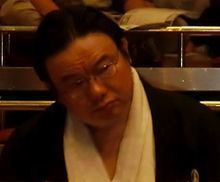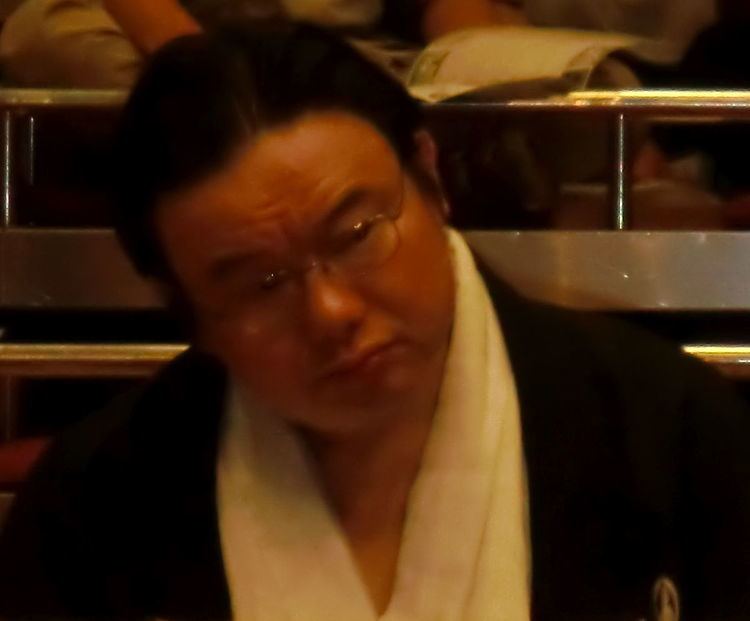Weight 129 kg (284 lb) Retired September, 1992 Makuuchi rank Sekiwake Record 551-567-29 Championships 1 (Jonokuchi) Height 1.82 m | Debut January 1978 Name Sakahoko Nobushige Children Chihana Amasaki Role Sumo Wrestler | |
 | ||
Born Yoshiaki Fukuzono June 18, 1961 (age 64) Kagoshima, Japan ( 1961-06-18 ) Parents Setsuko Terao, Tsurugamine Akio Similar People Terao Tsunefumi, Asahifuji Seiya, Hokutoumi Nobuyoshi, Tochinowaka Kiyotaka, Akinoshima Katsumi | ||
Highest rank Sekiwake (July, 1984) | ||
Sakahoko Nobushige (born 18 June 1961 as Yoshiaki Fukuzono) is a former sumo wrestler from Kagoshima Prefecture, Kyūshū, Japan. His highest rank was sekiwake. He is now the head coach of Izutsu stable. He is the elder brother of Terao Tsunefumi.
Contents

Career
Sakahoko made his professional debut in January 1978, joining Izutsu stable, which was run by his father, ex sekiwake Tsurugamine. His elder brother, Kakureizan, had joined sumo in March 1975, but Sakahoko quickly caught up with him and they made their jūryō debuts together in July 1981. Sakahoko made his debut in the top makuuchi division in November 1982. (His elder brother, meanwhile, never got higher than jūryō 2 and slid down the rankings). He reached what was to be his highest rank of sekiwake for the first time in July 1984. This was his first ever tournament in the titled san'yaku ranks and somewhat unusually for a san'yaku debutant he was able to produce a winning score (kachi-koshi) of 8–7. He received the Technique prize for his efforts. In March 1985 Sakahoko's younger brother Terao joined him in makuuchi. They were the first pair of brothers to be in the top division simultaneously since Tanikaze and Tatsugesake 200 years before.
In September 1987 he defeated two yokozuna, Chiyonofuji and Futahaguro, and was awarded the Outstanding Performance prize. He was promoted back to sekiwake and proceeded to hold the rank for a then record nine successive tournaments from November 1987 until March 1989, but he was never under consideration for promotion to ōzeki as he could not achieve regular double figure scores, his best result being 9–6. In July 1989, troubled by a shoulder injury, he turned in a disastrous 2–13 record and was demoted to the maegashira ranks. He managed to return to komusubi for one tournament in November 1990 but fell to jūryō in 1992 and announced his retirement that September at the age of 31 after 14 years in sumo. (Terao competed for another ten years, until September 2002). He chose the occasion of his retirement to publicly reveal for the first time that he was married with a seven-year-old daughter.
Sakahoko was unusual in that he accepted the prize money for winning a bout (kensho) with his left hand. Although yokozuna Asashoryu was later criticized for doing the same thing, no such criticism was ever attached to Sakahoko during his career.
Retirement from sumo
Sakahoko stayed in the sumo world as an elder of the Japan Sumo Association under the toshiyori name of Kasagayama. In 1994, when his father retired, he became Izutsu Oyakata and took over the running of Izutsu stable. The stable currently has one makuuchi wrestler, Kakuryū, who has surpassed Sakahoko and his father′s achievements by reaching the rank of yokozuna in March 2014. Izutsu also works as a judge of tournament bouts.
Fighting style
Unlike his brother Terao, who liked pushing and thrusting techniques, Sakahoko took after his father in specialising in yotsu-sumo or grappling techniques. He was well known for favouring the grip on the mawashi with both arms inside the opponent's, called moro-zashi. His most common winning kimarite was overwhelmingly yori-kiri or force out, which accounted for over half his victories at sekitori level.
